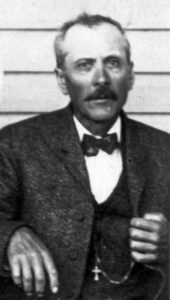
Joseph Voisin (1858-1916)
My paternal great-grandfather, Joseph Voisin was probably born January 10, 1858. For twenty-five years I’ve tried unsuccessfully to discover where he was born and who his parents were. I turn now to genetic genealogy, to both autosomal DNA and Y-DNA testing. Hopefully it will provide the additional clues needed to solve this mystery once and for all.
I have written about my “brick wall” (Brick by Brick Part 1, Brick by Brick Part 2). Here is a quick summary.
The names of Joseph Voisin’s parents are unknown, but his father’s name could also be Joseph Voisin.1 He perhaps lived for a time near St. Clements, which is near Kitchener, Ontario. There are several Voisin families in this area today. They are descendants of the patriarch Joseph Voisin (1805/7-1892). However there is no evidence yet that links our Joseph to these families.
Clues from a Journal
At age 17 in 1875 he wrote a poem, after which he indicated he was at Humberstone Township, near Netherby Post Office, Ontario.2
This was close to Niagara Falls, in Welland County. It is unknown whether Joseph lived there, or was perhaps visiting or attending school. Perhaps he came from across the river near Buffalo, New York. Then in 1877 at age 19 he wrote that he worked in Hawkesville, Ontario.3 This was near St. Clements and only a few miles from the homestead of the patriarch Joseph Voisin.
By age 21, Joseph left Ontario and immigrated to Michigan. He settled near Beal City in Nottawa Township, Isabella County, Michigan about 1879, the year he purchased 80 acres of land.
Approximate Locations
A map of Ontario from the time period shows Netherby and Humberstone, just west of Buffalo, New York, highlighted lower right.4 Joseph was in Humberstone Township in 1875. Two years later he was northwest of there in Hawkesville, near Berlin, highlighted upper left. Berlin was later renamed Kitchener due to anti-German sentiment during World War I.
A More Precise Location
Another map, from 1861, shows villages relevant to our story as well as property owners.5 Berlin (now Kitchener) is lower right. St. Clements is nine miles northwest of Berlin, and Hawkesville is three miles north, northeast of St. Clements. (Village names on the map are slightly offset.)
The patriarch Joseph Voisin owned land just east of St. Clements. Our Joseph Voisin was in Hawkesville, and also worked for an H. Otterbein in 1877, sixteen years after this map was published. An Otterbein owned land south of St. Clements, but it is unknown whether he is the same Mr. Otterbein, and whether he had moved to Hawkesville by that time.
Another early settler in the area, Ambrose Starr, owned land northwest of St. Clements and just west of Hawkesville. He was the father of Clements Starr, who would become a neighbor of our Joesph Voisin in Beal City, Michigan. One story says Joseph and Clements immigrated together and went to Remus, Michigan, before settling in Beal City.6
The circumstantial connections between Joseph Voisin and this area of Ontario are very intriguing. It is plausible he is related in some way to the family of the patriarch Joseph Voisin. If not his son, then perhaps he was a nephew or cousin.
Facial Comparison
When comparing faces, there may be a slight family resemblance. The patriarchal family7 generally had rounded faces with squared jaws and high cheek bones. Comparing Joseph X. Voisin below, standing, second from right, with our Joseph, notice the similar high cheek bones and rounded chin. Our Joseph also wore a similar mustache.
Renouncing Queen Victoria
A Declaration of Intention is further proof Joseph Voisin at least came from Canada, and perhaps from Great Britain.8 He filed a Declaration of Intention to become a naturalized citizen of the United States in October 1880. In it, he renounced his allegiance to the Queen of Great Britain. Unfortunately, no record of his being granted citizenship has yet been found.
Autosomol DNA
The mystery of Joseph Voisin’s origin might be solved one day through genetic testing. I recently tested my autosomal DNA.9 The results indicate I’m 98% European, which is further broken down to 49% British Isles, 36% East Europe, 9% Iberia and 4% Scandinavia. The remaining trace 2% is either Southeast Europe or simply “noise,” which is unexplained variations in the data.
Ethnicity predictions depend on many factors and are only approximate. They represent similarities of my DNA, my past really, with representative samples from modern populations.
The ethnicity map does agree strikingly with my mother’s lineage. Her father’s side was likely from Scotland and her mother’s side is proven to be from Hungary and Slovakia. However, I inherited roughly 50% of my autosomal DNA from my father. That means my father’s side is also some combination of this very same ethnic mix, with a little Spanish (9%) and Scandinavian (4%) thrown in somewhere.
Suppose I inherited 100% of my British Isles ethnicity from my mother. That would mean she was 98% British Isles. I would have inherited roughly 50% of her 98% resulting in my 49%. But I know she was also Eastern European, so she could not have been 98% British Isles. All that can be said is my ethnicity is mostly British Isles and East Europe. It doesn’t provide a definitive clue to the origin of Joseph Voisin’s parents.
Y-Chromosome DNA
Y-chromosomes are passed down from father to son, and ever so slowly mutate across generations. I inherited my father’s Y-chromosome, which he inherited from my grandfather, which he in turn inherited from my great-grandfather, Joseph Voisin. Therefore my most appropriate DNA test in this case is the Y-chromosome (Y-DNA) test.
My predicted haplogroup is R-M269, or R1b1a1a2, also formerly known as R1b1a2 (2003 to 2005), R1b1c (2005 to 2008), and R1b1b2 (2008 to 2011). It is the common haplogroup of modern Europeans. About 50,000 years ago as ancestors of this group left Africa, they evolved and the R-M269 mutation occurred about 4,000 to 10,000 years ago. They eventually traveled westward toward Germany and France. See the R1b path in the map below. That is precisely where many of my other paternal ancestors lived in the seventeenth and eighteenth centuries.
So my haplogroup seems consistent with an origin of central Europe for Joseph Voisin’s family too. My Y-DNA test measured Short Tandem Repeats (STR), which can only estimate my actual haplogroup. A test that measures Single Nucleotide Polymorphisms (SNP) is required to confirm that estimate. However if the prediction is correct, then a map of actual haplogroup matches (below) is also consistent with central Europe.
This map also shows a high concentration of haplogroup matches in the British Isles. Perhaps there is a component of my 49% British Isles ethnicity that was contributed by Joseph Voisin. He is mostly German however. He lived in a predominately German area of Ontario and moved to Beal City, Michigan, which was a German farming community. His wife Mary Ann (Yuncker) Voisin was from the German settlement of Westphalia, Michigan, and she spoke with a heavy German accent.
A preliminary conclusion then, if any conclusion can be drawn, is that Joseph Voisin’s family is more likely from southwest Germany, northwest France, or the Netherlands.
The Next Step
Unfortunately there is no one yet known who matches my Y-DNA test result. Hopefully a descendant of another Voisin family line somewhere in the world will also take a Y-DNA test. A match would indicate we are related and their family history might provide clues to the origin of my great-grandfather, Joseph Voisin.
Family lore says Joseph immigrated to Michigan with a brother. There is no evidence for this, but there are other Voisin families in northern and southern Michigan.
Ideally I would like to find a male descendant in the line of males who descended from the patriarch, Joseph Voisin (1805/7-1892), who lived near Kitchener, Ontario, Canada. That would at least prove or disprove that my great-grandfather is related to that Voisin family.
Are you a match? If you’ve had a Y-DNA test, or you would consider taking one, and there’s a chance we could be related, please contact me at mvoisin@gmail.com.
Footnotes- A. Wayne Edwards, II, Death Certificate of Joseph Voisin.
- A. Wayne Edwards, II, Images from the personal journal of Joseph Voisin. “Joseph Voisin is my name.”
- A. Wayne Edwards, II, Images from the personal journal of Joseph Voisin. “Take This Letter to My Mother.”
- Rand, McNally & Co.’s Ontario No. 1., David Rumsey Historical Map Collection, Image 4520009 (http://www.davidrumsey.com/ : downloaded 1 March 2017), 1879, pages 36-37.
- Ontario Historical County Maps Project: Historical Land Occupancy Information in 19th Century Ontario, Waterloo County (http://maps.library.utoronto.ca/hgis/countymaps/index.html : downloaded 1 March 2017).
- Ben Weber, Beal City Michigan Area Centennial 1875-1975.
- Frank W. Voisin and Clifton E. Voisin, “Joseph Voisin 1805-1892 and Descendants,” first printing (St. Clements, Ontario, Canada: St. Clements Printers, November 1982).
- Joseph Voisin, Volume 4, Page 99, October 11, 1880, Declarations of Intent for Naturalization, Circuit Court for Isabella County, Michigan; Department of Natural Resources, Archives of Michigan, Michigan Historical Center, Lansing, Michigan.
- I tested through Family Tree DNA (https://www.familytreedna.com/). It is currently the only testing service that tests Y-DNA.

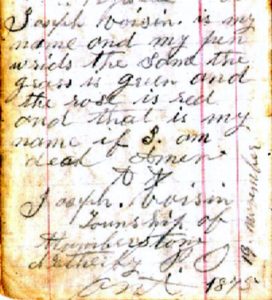
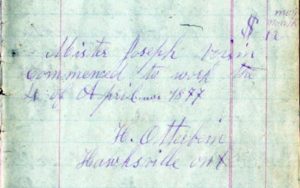
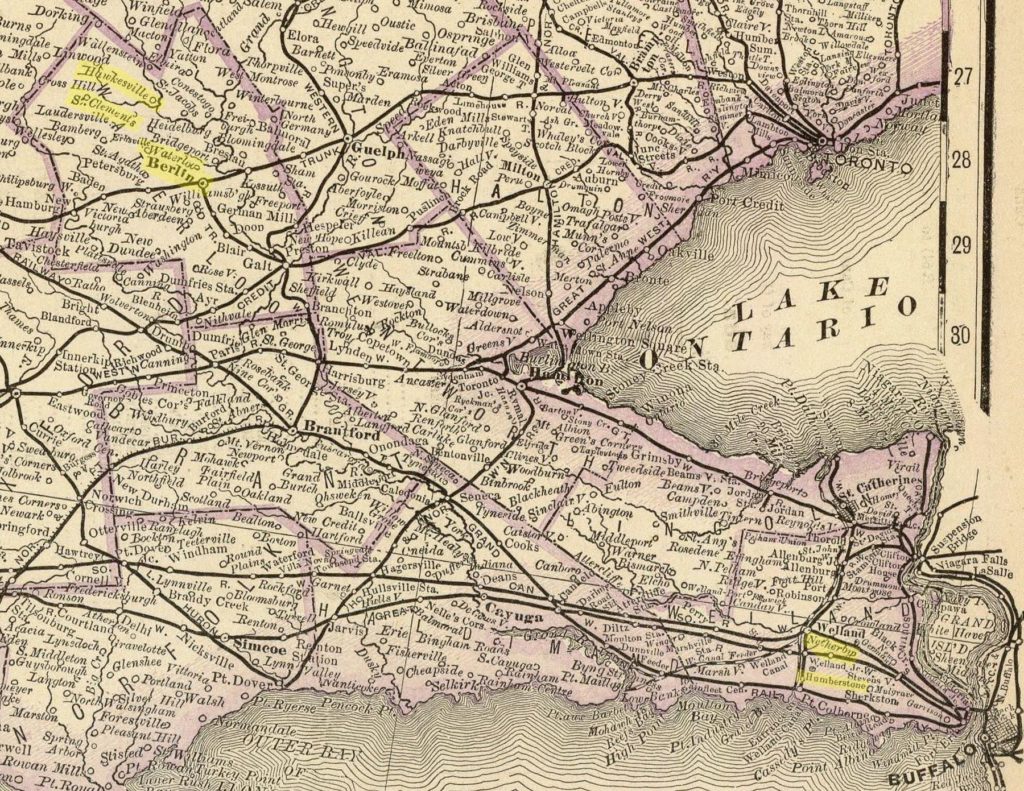


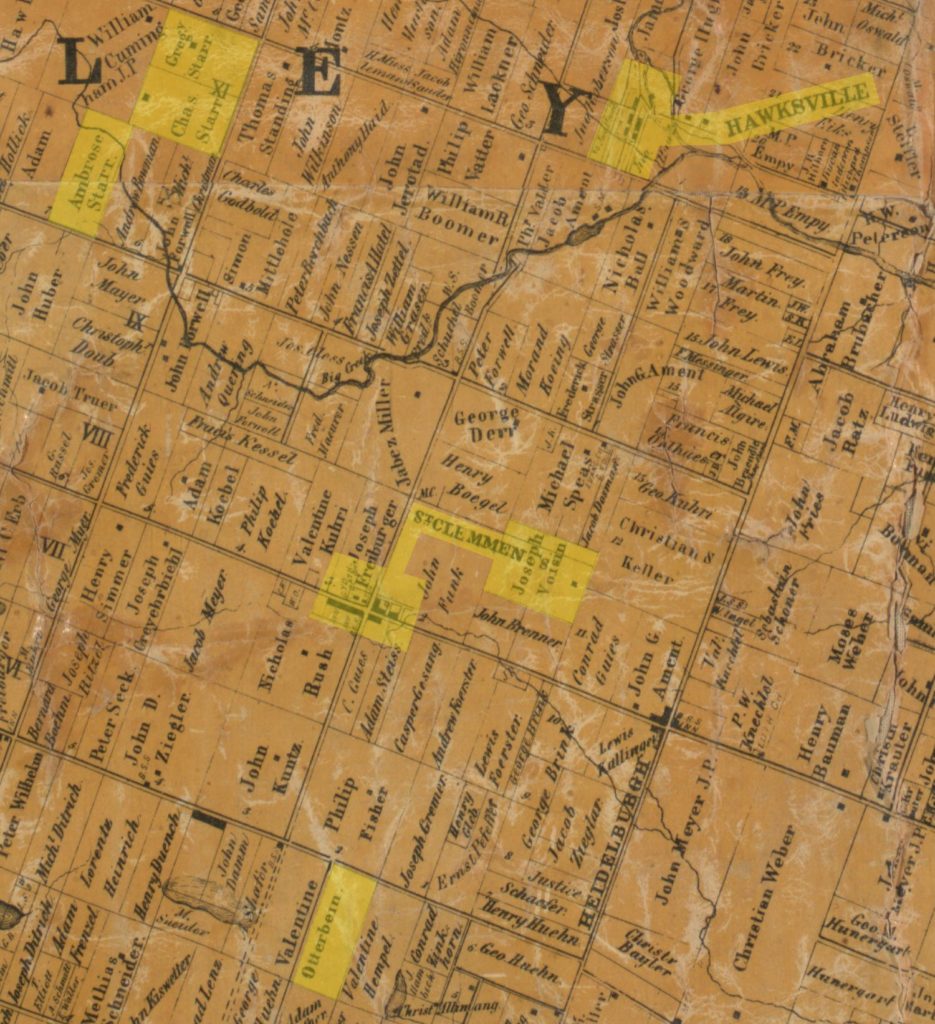
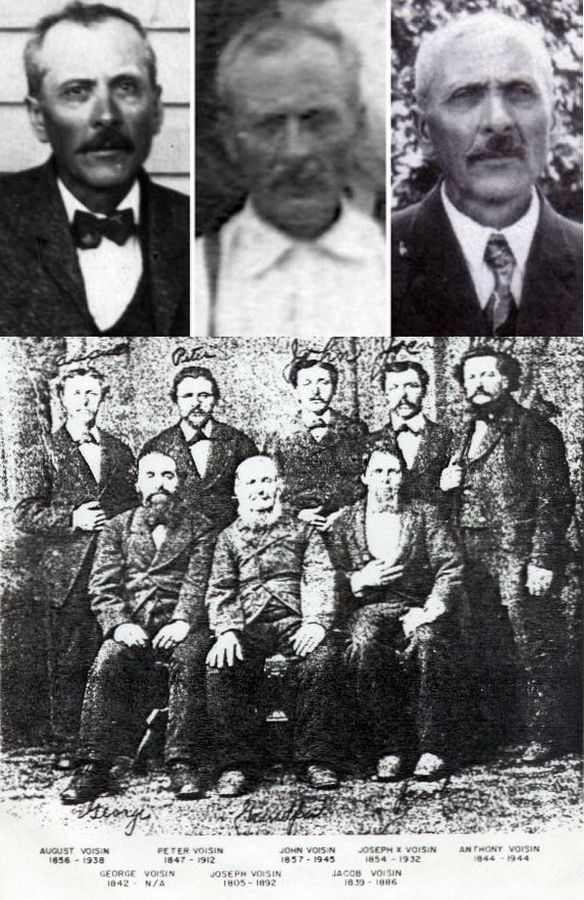
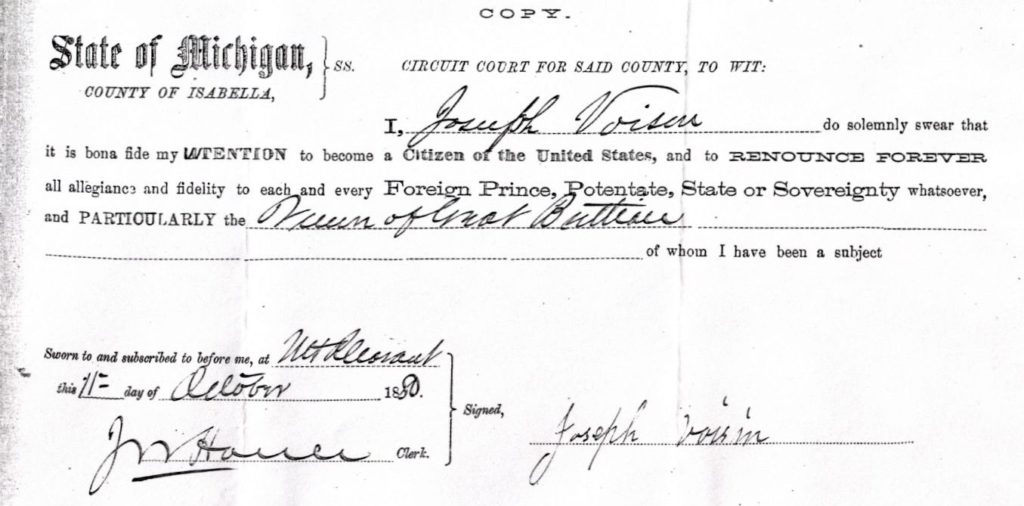
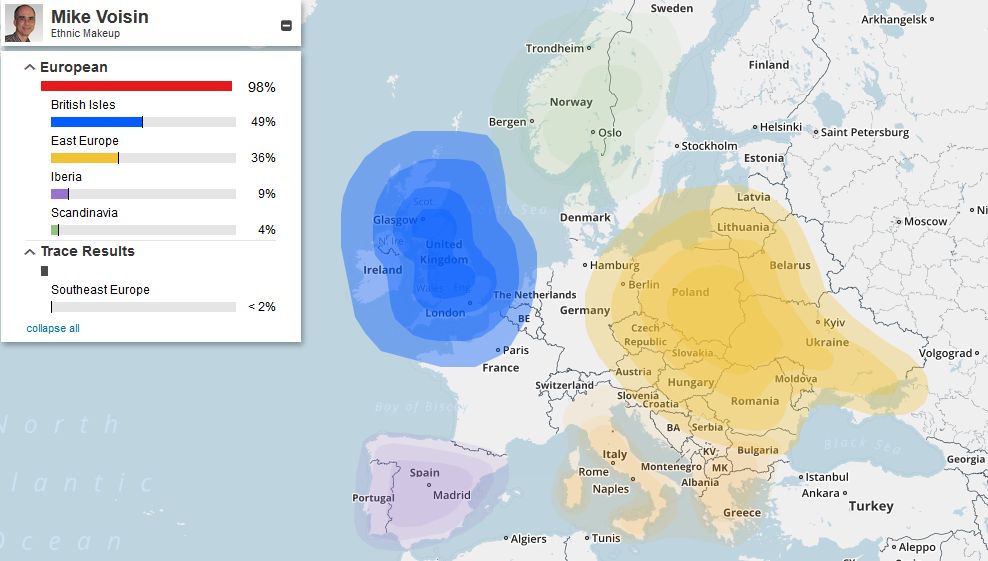

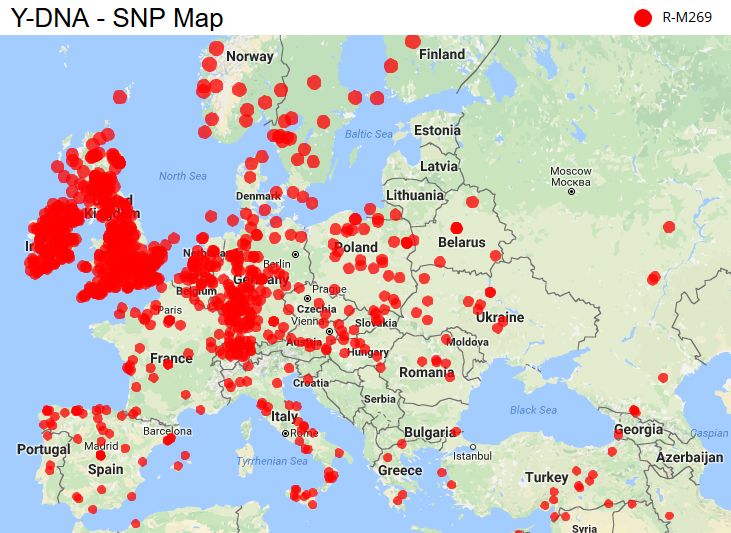

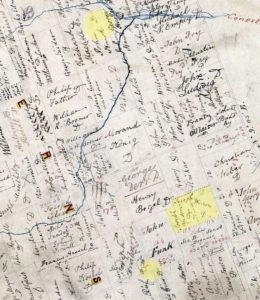


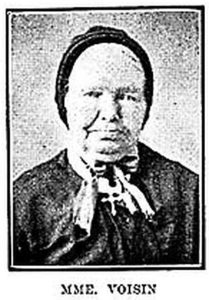
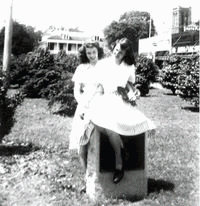
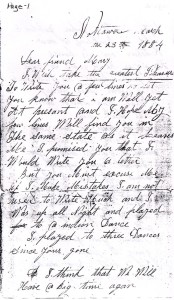

Good news! Clifton Voisin of Kitchener, Ontario agreed to take a Y-DNA test. He is a great-grandson of Peter Joseph “Joseph” Voisin (1805/7-1892). The results are in. It turns out the Voisin family of Michigan is definitely related to the Voisin family of Ontario. My Joseph shares a common ancestor with the Ontario patriarch. Precisely how he is related is still a mystery.
Clifton and I share 34 of 37 markers in our Y-chromosome DNA, which is a genetic distance of 3. The same Y-chromosome is passed from father to son down the paternal ancestral line. It can still mutate (change) and the number of differences in the DNA code between two related individuals gives an indication how far back a common ancestor lived. With DNA testing, it’s a matter of probability. In our case Clifton and I share a common ancestor within the last 4 generations with a probability of only 24%. Within 10 generations the probability is 82%, and within 20 generations it is 99%.
Peter Joseph Voisin known as Pedro Joseph Voisin is a Decendent of Ours!!!He lives in Louisiana and sold His Plantation and Went North to Join the Revolution!!!
The VOISINS All came from Lanquedoc,France!! They are Mostly All Knights Templars!!! Pierre De Voisin is the Patriart of the Voisin Family since the Crusades!! He owned Lands and Castles in the Pyrenees Mountains!! After the Inquisition the Family migrated to the New Worls!! Peter Joseph Voisin in 1757 sold His Sugar Plantation and Went North to Canada!! Buffaloe New York’s VOISINS are the same family!!!
I suspect at some point in the past most of the Voisin families are related. What evidence do you have for your conclusions? I would love to follow the paper trail to find our connections. So far, the Voisin families in Buffalo and Ontario arrived directly from the Reppe, Balschwiller, Belfort, and Guewenheim towns in France during the 1820s and 1830s. I haven’t found any connection to the Louisiana Voisins, nor any Y-DNA evidence. Perhaps there is a brother who went to Louisana while the others went to Ontario.